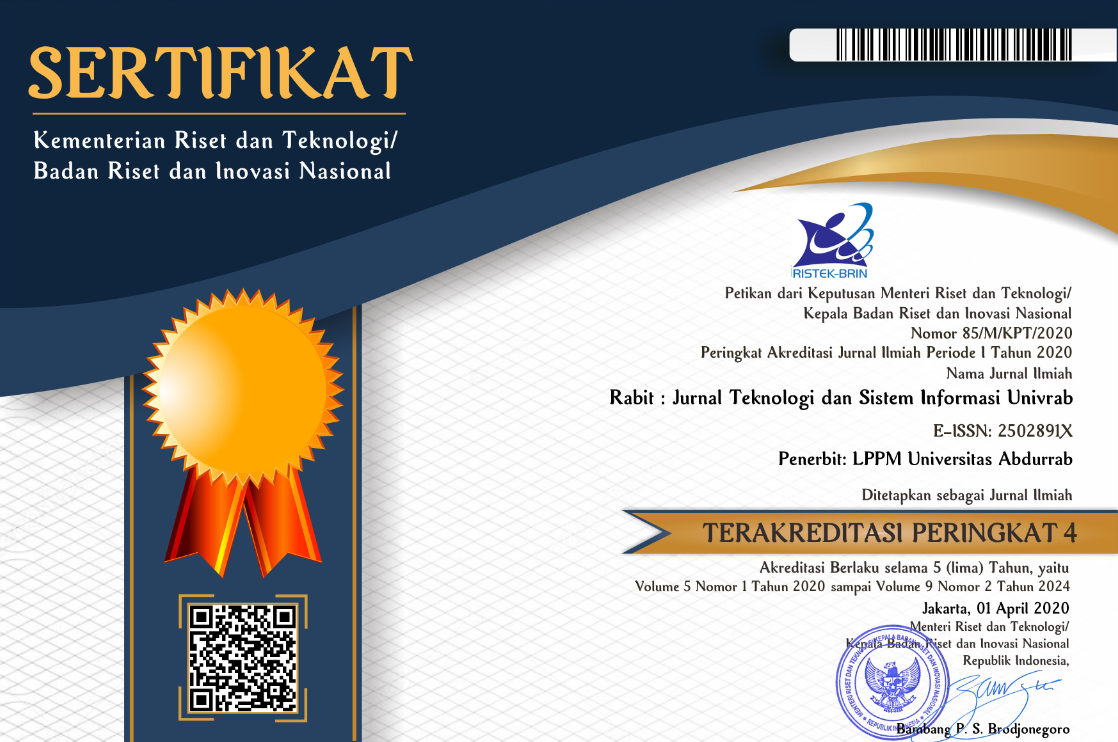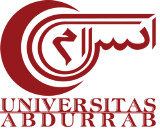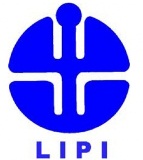Sistem Informasi Geografis Indikasi Tindak Kriminal Di Kecamatan Ujungbatu Rokan Hulu
Abstract
Crimes in many areas occur with different models and forms of events, this makes it difficult to determine areas that are significant unlike reference to the level of vulnerability to crime. Information system about follow-up needs to be obtained in real time by the public and law enforcement. Society in general, criminal information is very useful to find vulnerable points in travel and anticipatory actions, especially for the police. The level of anger as making a decision about the area of extra or unnecessary supervision needs to be done. For that, information is needed to map the crime that occurred in Ujungbatu District based on web using Google Maps. The resulting application outputs are graphic maps of crime information that occurred, which are grouped by kelurahan in Ujungbatu District. This is expected to help the community and facilitate the Ujungbatu District Police in analyzing crime rates
References
F. Putra, “Efektivtas Pemanfaatan Alokasi Dana Desa Di Desa Ujung Batu Timur Kecamatan Ujung Batu Kabpaten Rokan Hulu Tahun 2015,” Jom Fisip, Vol. 4, No. 1, 2017.
A. A. Balau, “Pemberlakuan Ketentuan Pidana Terhadap Pelaku Tindak Pidana Indikasi Geografis Menurut Undang-Undang Nomor 20 Tahun 2016 Tentang Merek Dan Indikasi Geografis1,” Lex Crim. Vol., Vol. Vii, No. 9, Pp. 79–86, 2018.
E. Irwansyah, Sistem Informasi Geografis: Prinsip Dasar Dan Pengembangan Aplikasi. Yogyakarta: Digibook, 2013.
M. Tumimomor, “Sistem Informasi Geografis Pariwisata Kota Kupang,” J. Nas. Pendidik. Tek. Inform., Vol. 1, Pp. 142–152, 2013.
Rismayani, “Pemanfaatan Teknologi Goole Maps Api Untuk Aplikasi Laporan Kriminal Berbasis Android Pada Polrestabes Makassar,” J. Penelit. Pos Dan Inform., Vol. 6, No. 2, Pp. 185–200, 2016.
A. S. Riyadi, “Perancangan Sistem Informasi Berbasis Website Subsistem Guru Di Sekolah Pesantren Persatuan Islam 99 Rancanbango,” J. Algoritm., Vol. 9, 2012.
A. ; M. S. Saputra, “Perancangan Dan Implementasi Mail Server Pada Cv . Sanjaya Anugerah Sejahtera ( Isp Jogjaringan ) Berbasis Open Source,” J. Dasi, Vol. 13, No. 2, 2012.
M. Muslihudin, Analisis Dan Perancangan Sistem Informasi Menggunakan Model Terstruktur Dan Uml. Penerbit Andi, 2016.
F. S. Handayani, “Perancangan Basis Data Website Wedding Organizer Sekapur Sirih,” J. Teknomatika, Vol. 4, No. 3, 2014.
E. Iswandy, “Kemampuan Fisik Atlet ( Studi Kasus : Fakultas Ilmu Keolahragaan ( Unp ) Padang ),” Vol. 2, No. 2, 2014.

This work is licensed under a Creative Commons Attribution-NonCommercial-ShareAlike 4.0 International License.
Copyright Notice
The copyright of the received article shall be assigned to the publisher of the journal. The intended copyright includes the right to publish the article in various forms (including reprints). The journal maintains the publishing rights to published articles. Therefore, the author must submit a statement of the Copyright Transfer Agreement.*)
This work is licensed under a Creative Commons Attribution-NonCommercial-ShareAlike 4.0 International License.
In line with the license, authors and any users (readers and other researchers) are allowed to share and adapt the material only for non-commercial purposes. In addition, the material must be given appropriate credit, provided with a link to the license, and indicated if changes were made. If authors remix, transform or build upon the material, authors must distribute their contributions under the same license as the original.
Please find the rights and licenses in RABIT : Jurnal Teknologi dan Sistem Informasi Univrab. By submitting the article/manuscript of the article, the author(s) accept this policy.
1. License
The non-commercial use of the article will be governed by the Creative Commons Attribution license as currently displayed on Creative Commons Attribution-NonCommercial-ShareAlike 4.0 International License.
2. Author’s Warranties
The author warrants that the article is original, written by stated author(s), has not been published before, contains no unlawful statements, does not infringe the rights of others, is subject to copyright that is vested exclusively in the author and free of any third party rights, and that any necessary written permissions to quote from other sources have been obtained by the author(s).
3. User Rights
RABIT's spirit is to disseminate articles published are as free as possible. Under the Creative Commons license, RABIT permits users to copy, distribute, display, and perform the work for non-commercial purposes only. Users will also need to attribute authors and RABIT on distributing works in the journal.
4. Rights of Authors
Authors retain all their rights to the published works, such as (but not limited to) the following rights;
- Copyright and other proprietary rights relating to the article, such as patent rights,
- The right to use the substance of the article in own future works, including lectures and books,
- The right to reproduce the article for own purposes,
- The right to self-archive the article,
- The right to enter into separate, additional contractual arrangements for the non-exclusive distribution of the article's published version (e.g., post it to an institutional repository or publish it in a book), with an acknowledgment of its initial publication in this journal (RABIT : Jurnal Teknologi dan Sistem Informasi Univrab).
5. Co-Authorship
If the article was jointly prepared by other authors, any authors submitting the manuscript warrants that he/she has been authorized by all co-authors to be agreed on this copyright and license notice (agreement) on their behalf, and agrees to inform his/her co-authors of the terms of this policy. RABIT will not be held liable for anything that may arise due to the author(s) internal dispute. RABIT will only communicate with the corresponding author.
6. Royalties
This agreement entitles the author to no royalties or other fees. To such extent as legally permissible, the author waives his or her right to collect royalties relative to the article in respect of any use of the article by RABIT.
7. Miscellaneous
RABIT will publish the article (or have it published) in the journal if the article’s editorial process is successfully completed. RABIT's editors may modify the article to a style of punctuation, spelling, capitalization, referencing and usage that deems appropriate. The author acknowledges that the article may be published so that it will be publicly accessible and such access will be free of charge for the readers as mentioned in point 3.
 PDF (Bahasa Indonesia)
PDF (Bahasa Indonesia)
 Abstract views: 636
Abstract views: 636
 downloads: 351
downloads: 351

 :
:












